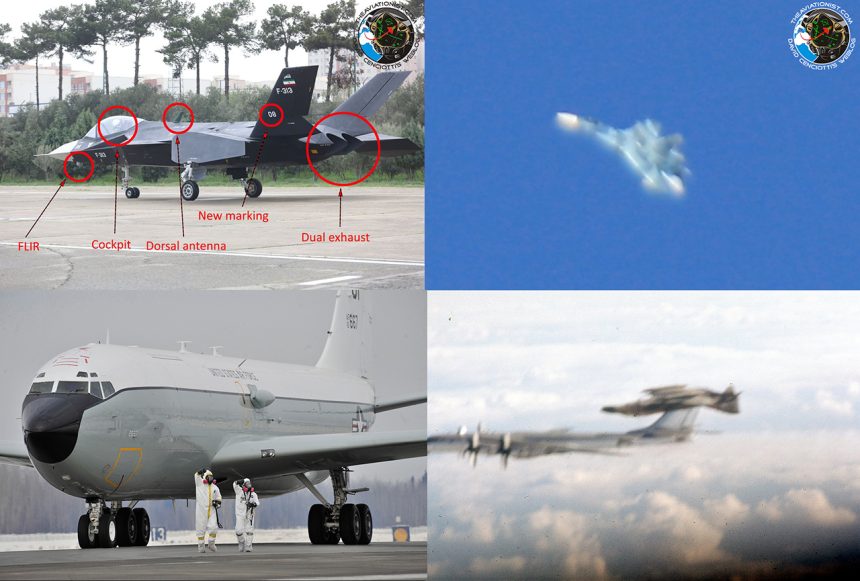The five top stories of The Aviationist provide the readers the opportunity to virtually review what happened in 2017.
Ordered by pageviews, the following 5 posts got the most reads and comments among the articles published on The Aviationist this year.
Needless to say, we have covered many more topics during the past year: the mysterious crash of an unidentified aircraft type that cost the life of Col. Eric Schultz; the Syrian Su-22 shot down by a U.S. Navy Super Hornet over Syria; the F-35 Lightning II (first special tail; first female pilot; Israeli IOC; birdstrikes and subsequent theories; etc); the Russian Su-57 (formerly PAK FA); the B-21 Raider; the North Korean crisis; some serious accidents across Europe; and much, much more…
BTW, we have also published an ebook on the A-10 Thunderbolt titled “BRRRTTT…deployments, war chronicles and stories of the last A-10 Warthogs” that is now available in paperback version on Amazon.
Please use the search feature on the site or select the proper category/tag to read all what we have written throughout the last year.
1) These crazy photos show a Russian Su-27 Flanker dogfighting with a U.S. Air Force F-16 inside Area 51
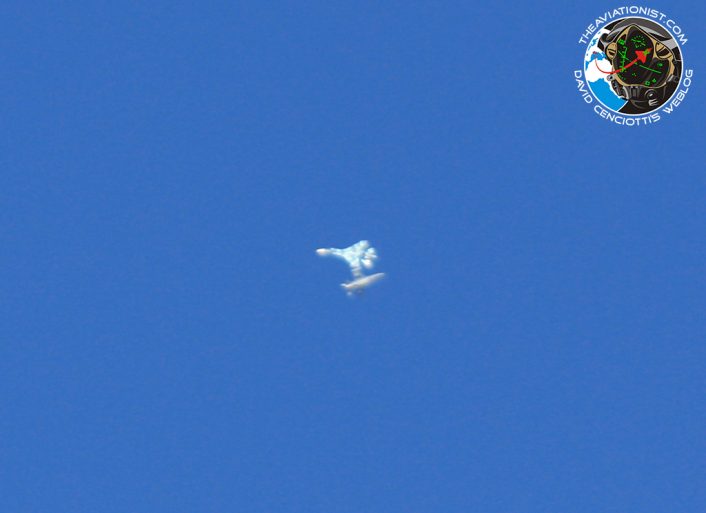
Jan. 06 2017
You don’t happen to see a Su-27 Flanker dogfighting with a F-16 unless you visit Area 51. Here are the amazing photographs taken near Groom Lake, on Nov. 8, 2016, U.S. election day.
The photographs in this post were taken from Tikaboo Valley, near Groom Lake, Nevada, by Phil Drake, who was lucky enough to observe a Su-27P Flanker-B dogfighting with an F-16, presumably one of the four Groom Lake based -D models in the skies of the famous Area 51.
Although the quality of the pictures is low (the aircraft were flying between 20K and 30K feet) they are extremely interesting since Flankers operating from Groom are not a secret (they have been documented in 2003 – 2004 and more recently between 2012 and 2014) but have rarely been photographed.
Here’s Phil’s report of the rare sighting:
“The date was November 8th, US election day, and the sighting was between 1500 and 1525.
I was visiting Nevada hoping to catch a glimpse of some of the latest defense programmes being tested.
On the Monday and Wednesday, Nellis Aggressor F-15s and F-16s were regularly overhead, dropping flares and sonic booms. It was Tuesday afternoon when the skies went quiet for a couple of hours, and I hoped this may be a sign of something unusual being flown.
Eventually the sound of jet noise caught my attention, and I scanned the clear blue skies ’til I saw the tiny speck of an approaching military jet at high altitude, leaving an intermittent contrail.
It was instantly recognisable as a Russian built Sukhoi 27 Flanker, and carried no national insignia or identifying marks.
…
[Continue here]
2) U.S. Air Force deploys WC-135 nuclear sniffer aircraft to UK as spike of radioactive Iodine levels is detected in Europe
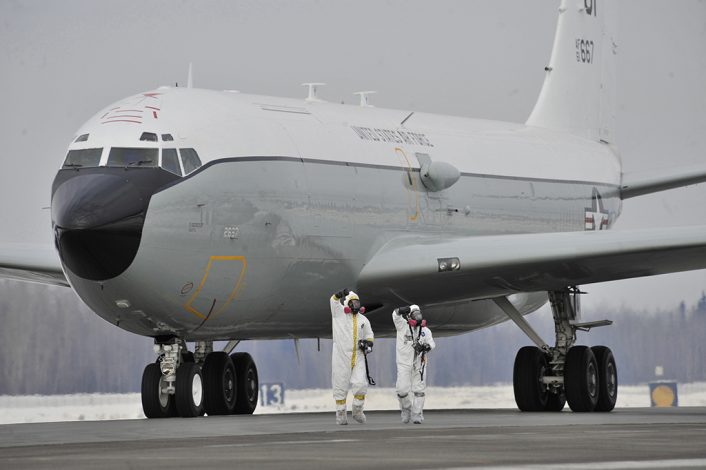
Feb. 19 2017
The USAF WC-135C Constant Phoenix might be investigating a spike in radioactive levels in Norway. Someone speculates the release of this radionuclide could be the effect of a Russian nuclear test.
On Feb. 17, 2017, U.S. Air Force WC-135C Constant Phoenix Nuclear explosion “sniffer,” serial number 62-3582, using radio callsign “Cobra 55” deployed to RAF Mildenhall, UK.
As we have already reported the WC-135 is a derivative of the Boeing C-135 transport and support plane. Two of these aircraft are in service today out of the ten examples operated since 1963. The aircraft are flown by flight crews from the 45th Reconnaissance Squadron from Offutt Air Force Base while mission crews are staffed by Detachment 1 from the Air Force Technical Applications Center.
The WC-135, known as the “sniffer” or “weather bird” by its crews, can carry up to 33 personnel. However, crew compliments are kept to a minimum during mission flights in order to lessen levels of radioactive exposure.
Effluent gasses are gathered by two scoops on the sides of the fuselage, which in turn trap fallout particles on filters. The mission crews have the ability to analyze the fallout residue in real-time, helping to confirm the presence of nuclear fallout and possibly determine the characteristics of the warhead involved.
…
[Continue here]
3) New Photos And Video of Iran’s Homemade F-313 “Qaher” Stealth Jet Have Just Emerged. And Here’s A First Analysis
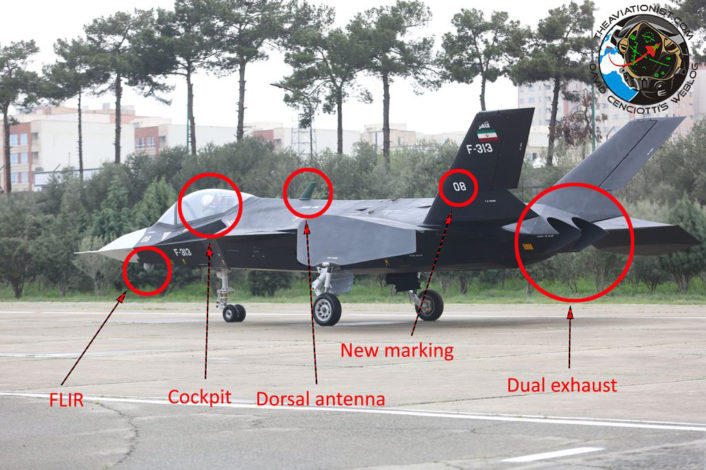
Apr. 15 2017
A new prototype of the weird Qaher 313 stealth jet has conducted taxi tests.
Footage and photographs showing a new prototype (marked “08”) of the famous Qaher F-313 stealth fighter jet have just emerged as Iran’s President Hassan Rouhani participated Saturday in an exhibition displaying the achievements that the Defense Ministry Brigadier General Hossein Dehqan gained during the past two years.
Indeed, an “upgraded version” of the “faux stealth fighter” can be observed performing taxi tests. The aircraft appears to be slightly different from the one unveiled on Feb. 2, 2013, that was nothing more than a poorly designed mock-up that would never fly unless it was extensively modified and heavily improved.
Four years ago, the cockpit was basic for any modern plane, the air intakes appeared to be too small, the engine section lacked any kind of nozzle meaning that the engine would probably melt the aircraft’s back-end. Above all, the aircraft was way too small to such an extent its cockpit could not fit a normal-sized human being.
The new prototype retains the original weird shape but has a more realistic cockpit, large enough to accommodate an Iranian test pilot on an ejection seat, with a “normal” canopy (the previous one was clearly made of plexiglass), and a dorsal antenna. It is equipped with dual exhaust nozzles: according to some sources these are U.S. engines, according to others these would be new turbofan engines or modified Iranian J-85s. And, interestingly, a sort of FLIR (Forward Looking Infra-Red) turret was attached to the nose of the aircraft, that also features a white radome.
Although the new prototype is not a complete joke as its predecessor, it is still pretty hard to say whether it will be able to take to the air and land safely without further modifications: the intakes continue to appear smaller than normal (as commented back in 2013, they remind those of current drones/unmanned combat aerial vehicles); the wing are small as well and feature the peculiar design with the external section canted downward whose efficiency is not clear.
…
[Continue here]
4) U.S. Department Of Defense Video Shows Unknown Object Intercepted By U.S. Navy Super Hornet And We Have No Idea What It Was.
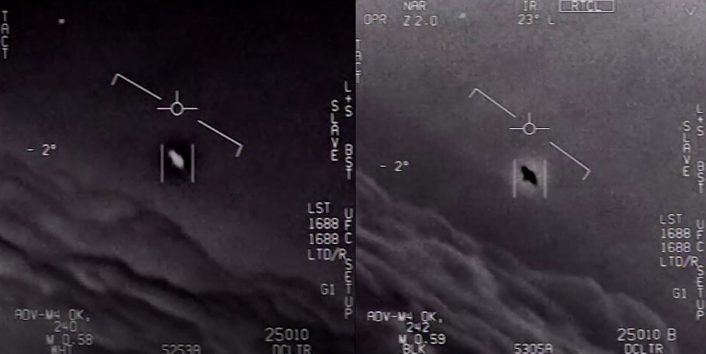
Dec. 12 2017
This video shows the weird object as seen from a U.S. Navy F/A-18F Super Hornet’s ATFLIR (Advanced Targeting Forward Looking Infrared) pod. What is it? Any idea?
On Dec. 16, the NYT published an interesting story about a U.S. Department of Defense program that investigated reports of UFOs (unidentified flying objects). Along with interviews with program participants and records they obtained investigating the mysterious Pentagon program, The New York Times has released a video that shows a close encounter between an F/A-18F Super Hornet out of USS Nimitz and one of these UFOs back in 2004.
Back in 2007, a user (cometa2) of the popular Above Top Secret (ATS) forum posted an alleged official CVW-11 Event Summary of a close encounter occurred on Nov. 14, 2004. Back then, when the encounter had not been confirmed yet, many users questioned the authenticity of both the event log and the footage allegedly filmed during the UFO intercept. More than 10 years later, with an officially released video of the encounter, it’s worth having a look at that unverified event log again: although we can’t say for sure whether it is genuine or not, it is at least “realistic” and provides some interesting details and narrative consistent with the real carrier ops. Moreover, the summary says that the callsign of the aircraft involved in the encounter is Fast Eagle: this callsign is used by the VFA-41 Black Aces – incidentally the very same squadron of David Fravor, formed Co of VFA-41, the pilot who recalled the encounter to NYT.
…
[Continue here]
5) Rare Photo Shows F-4 Phantom Flying Inverted While Intercepting A Russian Tu-95 Bear Bomber

Dec. 04 2017
“Because I was….inverted!”: Top Gun stunt performed near a Russian strategic bomber.
In the last few years, we have often reported about “unsafe and unprofessional” intercepts conducted across the world by Russian (and Chinese) fighter jets scrambled to identify and escort U.S. spyplanes flying in international airspace.
Barrel rolls, aggressive turns that disturbed the controllability of the “zombie” (intercepted aircraft in fighter pilot’s jargon), inverted flight: if you use the search function on this site you can read of several such incidents that made the news on media all around the world.
The last episode involved a Russian Su-30 that crossed within 50 feet of a U.S. Navy P-8 Poseidon’s path over the Black Sea during an intercept mission, causing the American maritime patrol aircraft to endure violent turbulence, on Nov. 25, 2017.
However, as a former RC-135 aircraft commander who flew the S, U, V, W, and X models, told us a couple of years ago:
“Prior to the end of the Cold War interceptors from a variety of nations managed to get into tight formation with RC-135s and EP-3s. Smaller airplanes like MiG-21s made it easy. The challenge with the larger airplanes like the Su-27 and MiG-31 is the sheer size of the interceptor as it moves in front of any portion of the intercepted plane.
At least the Su-27 pilot has excellent all-around visibility to see where the back-end of his own airplane is as he maneuvers adjacent to the RC-135.
The U-Boat crew took video of the intercept, which has not been released but shows the precise extent of how close the FLANKER really was. Recent movies taken by a PRC aircraft that was intercepted by a JASDF F-15CJ suggests that the Eagle was very close—until the camera zooms out and shows the Eagle was 70-100 feet away from the wingtip….
Finally, although the number of Russian reactions to Western recon flights has been increasing recently, for 15-20 years (certainly from 1992 through 2010) there were almost no reactions on a regular basis. As such, what passes for dangerous and provocative today was ho-hum to recon crews of my generation (although we weren’t shot at like the early fliers from 1950-1960).”
…
[Continue here]

